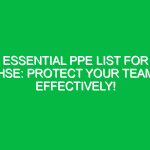Introduction
Hello team! Today, we’re gathered for a crucial toolbox talk focused on a vital component of our work culture: Taking Action to Work Safe. Safety is not just a checklist; it’s a mindset we must adopt every day. This talk will explore practical strategies and Best Practices that ensure we all contribute to a safe working Environment. Let’s dive in!
The Importance of Taking Action to Work Safe
Every day, we face potential Hazards in our work environment. From slips and falls to equipment malfunctions, the risks are ever-present. However, by Taking Action to Work Safe, we can significantly reduce the likelihood of accidents and injuries. Understanding the importance of Safety in our daily operations not only protects us but also fosters a culture of accountability and care among colleagues.
Understanding Hazards and Risks
To effectively take action, we must first recognize the hazards around us. Hazards can be classified into several categories:
- Physical Hazards: These include slips, trips, falls, and machinery hazards.
- Chemical Hazards: Exposure to harmful substances like solvents, fumes, or dust.
- Biological Hazards: Risks from bacteria, viruses, or other microorganisms.
- Psychosocial Hazards: Stress, harassment, and workplace violence.
Each of these hazards can lead to severe consequences if not addressed promptly. By identifying these risks, we can implement strategies to mitigate them effectively.
Real-Life Example: The Importance of Awareness
Consider a scenario where a team member notices a spill on the floor but decides to ignore it. Later, someone slips and injures themselves. This incident could have been prevented if the initial team member had taken action. Recognizing hazards and acting on them is crucial for maintaining Safety.
Strategies for Taking Action to Work Safe
Now that we understand the importance of identifying hazards, let’s discuss actionable strategies for Taking Action to Work Safe.
1. Conduct Regular Safety Inspections
Setting aside time each week for safety inspections can help identify potential hazards before they lead to accidents. Involve the entire team in these inspections to foster a sense of collective responsibility. Document any findings and prioritize addressing the most critical issues.
2. Use Personal Protective Equipment (PPE)
PPE is essential in minimizing exposure to hazards. Always wear the appropriate gear for your specific tasks. For instance, hard hats, gloves, goggles, and hearing protection can prevent injuries. Remember, PPE is only effective if worn correctly and consistently.
3. Engage in Continuous Training
Safety training should not be a one-time event. Regularly scheduled training sessions keep safety at the forefront of our minds. Encourage team members to share insights from their experiences, which can be invaluable in understanding how to tackle potential risks.
4. Foster Open Communication
Encouraging open communication about safety concerns creates a proactive safety culture. Team members should feel comfortable reporting hazards or unsafe conditions without fear of repercussions. Consider implementing a “safety suggestion box” where employees can anonymously submit concerns or ideas.
5. Develop Emergency Response Plans
Every workplace should have a clear emergency response plan. Ensure that all employees are familiar with the Procedures for various emergencies, including Fires, chemical spills, and severe weather. Conduct regular drills to reinforce these procedures and identify any areas for improvement.
Benefits of Taking Action to Work Safe
When we prioritize safety through proactive measures, the Benefits are profound:
- Reduced Injuries: A safe workplace minimizes the risk of accidents, leading to fewer injuries and illnesses.
- Increased Productivity: Employees who feel safe are more focused and productive.
- Improved Morale: A culture of safety fosters trust and loyalty among team members.
- Regulatory Compliance: Adhering to safety Regulations helps avoid fines and legal issues.
Best Practices for Toolbox Talks
A well-conducted toolbox talk can significantly enhance safety awareness among employees. Here are some Best Practices to keep in mind:
1. Be Relevant
Focus your discussions on issues that are pertinent to the specific work environment. Tailoring the talk to current tasks or recent incidents keeps the conversation relevant and engaging.
2. Encourage Participation
Invite team members to share their experiences and insights. This not only enriches the discussion but also empowers employees to take ownership of their safety.
3. Use Visual Aids
Incorporate visuals such as posters, videos, or demonstrations to enhance understanding. Visual aids can help illustrate complex safety concepts or procedures more effectively than words alone.
4. Follow Up
After each toolbox talk, follow up on the discussed points. Revisit any actions taken and encourage ongoing dialogue regarding safety. This reinforces the importance of the topic and ensures that it remains a priority.
Regulations and Standards in HSE
Understanding the regulatory framework surrounding Workplace Safety is vital. Regulations such as the Occupational Safety and Health Administration (OSHA) standards dictate the minimum safety requirements for various industries. Compliance not only protects employees but also safeguards the organization from legal repercussions.
Regularly review these regulations and ensure that all employees are trained on relevant standards. This will help reinforce the importance of Taking Action to Work Safe in our daily operations.
Conclusion
In conclusion, Taking Action to Work Safe is a shared responsibility that requires our collective effort. By identifying hazards, implementing Safety Strategies, and fostering a culture of communication and training, we can create a safer workplace for everyone. Remember the importance of engaging in regular toolbox talks and applying what we learn every day.
Thank you for your attention and your commitment to safety. Let’s work together to ensure that we all go home safe at the end of the day!


